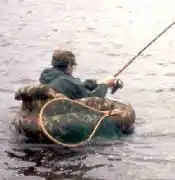A payaos is a type of fish aggregating device used in Southeast Asia, particularly in the Philippines. Payaos were traditionally bamboo rafts for handline fishing before World War II, but modern steel payaos use fish lights and fish location sonar to increase yields. While payaos fishing is sustainable on a small scale, the large scale, modern applications have been linked to adverse impacts on fish stocks.
Traditional payaos
A traditional payaos is a simply constructed bamboo raft with a superstructure at or just below the waterline, most commonly constructed of palm fronds. Using hand-line fishing, fishermen take advantage of pelagic fish's attraction to floating objects. Large tuna can be caught in this manner at depths of under 300 meters, far shallower than by contemporary methods like purse seining.[1] Before World War II anchored and drifting payaos were deployed in all Philippines regional waters barring the east, where strong currents prohibited it.[1] Payaos are frequently anchored in the coastal waters, passively fishing for migrating fish.
The chronic overfishing of regional Philippine waters, combined with the low impact of shallow-water payaos fishing, has led to the establishment of the Tuna Productivity Project in Davao Gulf. This will encourage traditional and environmentally sound fishing, and aims to decrease the catch of juvenile fish.[2]
Modern payaos
The traditional payaos has been adapted to meet the demand for commercially sized catches. They are now commonly used in conjunction with purse seiners, pump boats, and gillnet fishing. The success of these methods has greatly increased the pressure on fish stocks.[3] The use of lighted payaos to attract fish has also had a large impact on catch size and profitability,[4] and by the 1980s over 2,000 commercial payaos were being used in the Moro Gulf alone.[5] By this time most other South Pacific nations had payaos programs and were seeking to improve their designs for increased durability for use in open ocean environments.[6] In particular, the drifting payaos using seines, as well as the lighted anchored payaos, catch juvenile tuna and byproduct fish, thereby affecting the lifecycle of the tuna beyond the simple loss of numbers from the catch.
No international policy has been set on the placement of payaos, and many are currently deployed in sea lanes, presenting a navigational hazard. The replacement of bamboo with steel cages has also increased potential danger from collision and entanglement.[7]
See also
References
- 1 2 Wesley A. Armstrong and Charles W. Oliver, "Recent Use of Fish Aggregating Devices in the Eastern Tropical Pacific Tuna Purse-Seine Fishery: 1990-1994," Southwest Fisheries Science Center. PDF. Last accessed 20 December 2006
- ↑ Malcolm I. Sarmiento, Jr and Cesar M. Drilon, Jr, "Establishment of Tuna Productivity Project in Davao Gulf," Republic of the Philippines (Department of Agriculture). Last accessed 20 December 2006
- ↑ Haruko Yamashita, "Problems of Export-Oriented Yellowfin Tuna Industry -Indonesia and the Philippines," Meikai University. PDF Archived 2006-09-15 at the Wayback Machine. Last accessed 20 December 2006
- ↑ T. Yonemori, H. Yanagawa and Lui Yean Pong," "Interactions of longtail tuna fisheries in the western South China Sea," Southeast Asian Fishery Development Center. Last accessed 20 December 2006
- ↑ A.D. Lewis, "Review of tuna fisheries and the tuna fishery statistical system in the Philippines," Commission for the Conservation and Management of Highly Migratory Fish Stocks in the Western and Central Pacific. PDF Archived 2007-10-06 at the Wayback Machine. Last accessed 20 December 2006
- ↑ Raymond M. Buckley, David G. Itano and Troy W. Buckley, "Fish Aggregation Device (FAD) Enhancement of Offshore Fisheries in American Samoa," Workshop on Pacific Inshore Fishery Resources. PDF. Last accessed 20 December 2006
- ↑ Ricardo G. Sigua and Glenn D. Aguilar, "Maritime Incident Analysis Using GIS," Journal of the Eastern Asia Society for Transportation Studies vol. 5, October 2003. PDF. Last accessed 20 December 2006

